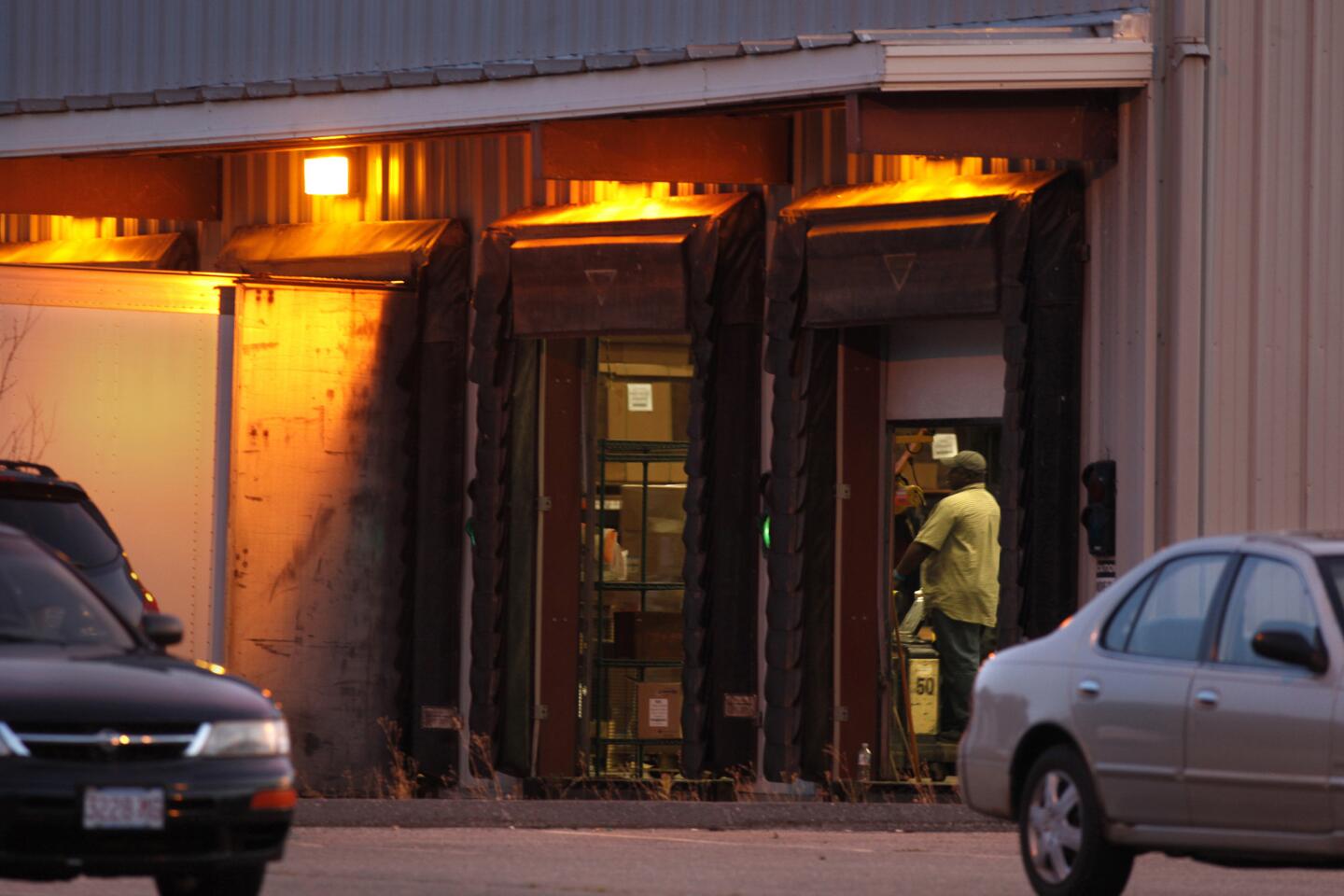As employers push efficiency, the daily grind wears down workers
WESTFIELD, Mass. â The envelope factory where Lisa Weber works is hot and noisy. A fan she brought from home helps her keep cool as she maneuvers around whirring equipment to make her quota: 750 envelopes an hour, up from 500 a few years ago.
Thereâs no resting: Between the video cameras and the constant threat of layoffs, Weber knows she must always be on her toes.
The drudgery of work at National Envelope Co. used to be relieved by small perks â an annual picnic, free hams and turkeys over the holidays â but those have long since been eliminated.
PHOTOS: National Envelope Company
âItâs harder for me to want to get up and go to work than it used to be,â said Weber, 47, who started at the factory at 19. âItâs not something I would wish on anybody. Iâm worn out. I get home and I can barely stand up.â
The relentless drive for efficiency at U.S. companies has created a new harshness in the workplace. In their zeal to make sure that not a minute of time is wasted, companies are imposing rigorous performance quotas, forcing many people to put in extra hours, paid or not. Video cameras and software keep tabs on worker performance, tracking their computer keystrokes and the time spent on each customer service call.
Employers once wanted long-term relationships with their workers. At many companies, thatâs no longer the case. Businesses are asking employees to work harder without providing the kinds of rewards, financial and psychological, that were once routine. Employers figure that if some people quit, there are plenty of others looking for jobs.
âWages are stagnant, jobs are less secure, work is more intense â itâs a much tougher world,â said Paul Osterman, co-director of the MIT Sloan Institute for Work and Employment Research. âEmployers have become much more aggressive about restructuring work in ways that push for higher levels of productivity.â
Work is seeping into off hours, as bosses pepper employees with email messages at night and on weekends. They monitor employeesâ Facebook pages and Twitter feeds for comments that conflict with the corporate message. The growing demands at the workplace mean people have less time to spend with their families or to help out with youth sports or other volunteer activities.
VIDEO: Changes in the workplace
Matt Taibi of Providence, R.I., routinely works 12-hour days as a driver for UPS. The company would rather pay him and other drivers overtime instead of hiring more workers.
Taibi has no complaints about his pay. He makes $32.35 an hour, plus benefits, and has job security as a Teamster. But he wonders how much longer he can keep up the breakneck pace.
âThereâs more and more push towards doing more with less workers,â said Taibi, 35. âThere are more stops, more packages, more pickups. Whatâs happening is that weâre stretched to our limits and beyond.â
Changes such as these began decades ago and accelerated during the Great Recession, when high unemployment enabled companies to offer less and demand more. Although the economy is improving, companies are still squeezing labor costs to contend with global competition and boost profits, aided by an array of technologies and management strategies.
There are exceptions, especially in knowledge-based industries where talent is scarce. In Californiaâs Silicon Valley, technology companies try to retain software engineers with an ever-increasing array of benefits.
But these jobs go largely to engineers educated at elite universities. Those who donât have a college education or specialized skills face a working world that is far less stable and rewarding.
Santos Castaneda saw his job unloading trucks in the warehouses of the Inland Empire go from a full-time position to a temporary one, in which he never knew from week to week how often heâd be called in or how much heâd earn.
âThey say, âIf you donât want to work, you can leave, but there are hundreds of people waiting for a job,ââ he said.
This points to the emergence of a two-tiered workforce in which fewer people can expect the type of employment relationship that Americans aspired to in the past.
âIf youâre a highly skilled employee with highly marketable talents, theyâre going to pay dearly for you. But if youâre a relatively fungible person, with nothing that separates you from anybody else, the risks and costs have been shifted to you at a dramatic rate,â said Rita Gunther McGrath, a management professor at Columbia Universityâs business school.
Lisa Weberâs employer, National Envelope, was founded in 1952 by a Polish immigrant and Holocaust survivor named William Ungar.
As the company flourished, Ungar came to believe that being good to employees was good for business. âFor a company like ours to achieve its goals, it must have a humane approach to our employees, thereby stimulating their creativity, which in turn will improve our productivity and efficiency,â he wrote in his memoirs.
But National Envelope had to retrench as the decline of paper mail eroded its business. In 2009, the company shut down some plants. It filed for bankruptcy the following year.
In 2010, National Envelope was acquired by the private equity firm Gores Group of Los Angeles, which drew on the standard playbook for such takeovers: Close inefficient plants, cut staffing and demand more from remaining employees. The company has fewer than 2,500 employees now, half the number it had in 2001.
Workers are being asked to do more even as their benefits shrink, said Juan Roman, vice president of the local union that represents workers at the Westfield, Mass., plant.
Employees can accrue up to four weeks of vacation, rather than five; gone are profit sharing and pensions. Workers are now responsible for 1-1/2 machines each,
rather than one, said Roman, who worked at the plant for 23 years until recently becoming a union staff member.
âYou do what you have to do to keep the doors open,â he said.
Tough as they may be, those measures have allowed people like Roman and Weber to continue earning paychecks while many of their neighbors are sitting home unemployed, the firm contends.
âGenerally, the business had been run the same way since its inception,â said Tim Meyer, a Gores Group executive. âIt became clear that as the market began to soften, what was in place was not a sustainable business model.â
âSometimes you have to make dramatic changes to save the jobs that you can,â he said.
Businesses are encouraged to keep fixed costs, such as labor and rent, as low as possible. That has paid off: The amount of profit companies make per employee has risen 34% since 2004, according to financial analysis firm Sageworks.
But the focus on costs is part of what has made work more stressful for so many.
âRaises are less. Bonuses are less. Managers are required to do clerical work, the staff is so small,â said John Kennedy, a broker at a securities trading firm in Manhattan. âWe joke about bringing our own equipment to work.â
Kennedy has thought about leaving, but he is worried that the job market isnât good enough for him to go anywhere else.
His situation is an example of how professionals are experiencing the harsher work environment too. Although long hours were always part of the bargain, professionals often enjoyed a measure of autonomy in their schedules, with the freedom to take off early on a Friday afternoon after a grueling week.
Thatâs increasingly rare. David Tayar spent a decade as an associate attorney at the law firm Paul, Weiss, Rifkind, Wharton & Garrison in Manhattan. He said the demands of the job grew so much in that time, he eventually felt he could never take a break.
When he started, Tayar said, he checked his voice mail every few hours. Today, lawyers must check their BlackBerrys every few minutes â and be prepared to cancel a dinner, weekend trip or vacation at a momentâs notice. Tayar said he took just one dayâs vacation in a five-year stretch.
âYou can never totally relax â you could be called at any time, unless youâre officially on vacation,â Tayar said. âAnd even if you are, there are times when youâre called in to work.â
He left the firm last year for a lower-stress job as general counsel of a laser hair-removal company.
The workplace is even tougher for the millions of Americans who have lost the security of a steady paycheck, as companies rely more on temporary staffing agencies. Temp jobs used to be a gateway to permanent employment. Increasingly, they have become a way of life. About 25% of the workforce is temporary, according to research firm Aberdeen Group, up from 17% in 2009.
âBusinesses are operating fundamentally differently now than they did before the recession,â said Steven Berchem, chief operating officer of the American Staffing Assn., a trade group for temporary help agencies. âCompanies are saying, âI donât need to hire a worker in a permanent job for many of the things that used to be done before.ââ
That means people such as Martha Gonzalez of Indianapolis are always on call but never guaranteed a weekly paycheck. The Hyatt housekeeper has no sick or vacation days, and she never knows when the staffing agency might call and say she wonât be needed for a while.
âYou canât really miss a day,â said Gonzalez, 28, who goes to food pantries to feed her family when work is slow. âIf you miss a day, theyâll fire you.â
Matt Ides has a doctorate in history and extensive teaching experience. Unable to find a full-time, tenure-track job, he took an adjunct teaching position at Eastern Michigan University, where he was paid $3,500 per class. He taught five classes one semester and four the next. One more class and the university would have had to consider him a full-time employee under university policy.
If not for his girlfriendâs salary, he said, âI would have had to live in a one-room apartment and eat soup every day.â
Few people have had a better view of the changes taking place in the workplace than human resource professionals. They used to oversee hiring, alert employees to professional development opportunities, put out company newsletters and stage special events to boost morale.
Now theyâre asked to cut back on those benefits and to evaluate employees based on statistics to figure out who is dispensable.
âIn this economy, theyâre looking for shortcuts, better ways to spend less money,â said Florence Kurttila, who was a human resources specialist at a manufacturing firm until the recession put her out of work.
Kurttila was among HR professionals attending a conference in Sacramento last year in hopes of finding a job. Five years ago, companies averaged nearly 4 human resource workers for every 100 employees, according to the Society for Human Resource Management. Today, the ratio is around 2 per 100 workers, and they are more likely to be terminating employees than helping them get ahead.
Like the colleagues they advise in cubicles and on factory floors, HR workers are under pressure. Computer programs that evaluate employees have made some of them superfluous. Many companies no longer see the need for an in-house HR department and have outsourced the work.
âThe relationship between employers and employees has changed,â HR specialist Donna Prewoznik said over a glass of white wine in the conference hotelâs ballroom. âEmployees havenât had raises. Theyâre tired. Their hours are reduced. They feel a little bit betrayed.â
*
About this story
This is the first of two articles about how technology and global competition are changing the workplace.
Monday: How businesses monitor and measure employee performance.
More to Read
Inside the business of entertainment
The Wide Shot brings you news, analysis and insights on everything from streaming wars to production â and what it all means for the future.
You may occasionally receive promotional content from the Los Angeles Times.















